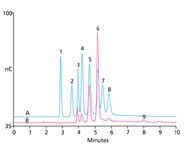Rapid and Sensitive Determination of Biofuel Sugars
Biofuels have emerged as an attractive alternative to fossil fuel. Biofuel refers to any fuel that is derived from biomass (typically, plant and animal waste). A common feedstock for bioethanol production is corn stover (leaves and stalks of maize plants left after harvesting). Corn stover processing involves acid treatment to release a mixture of water-soluble carbohydrates, followed by enzymatic reactions to convert the sugars to ethanol.
Biofuels have emerged as an attractive alternative to fossil fuel. Biofuel refers to any fuel that is derived from biomass (typically, plant and animal waste). A common feedstock for bioethanol production is corn stover (leaves and stalks of maize plants left after harvesting). Corn stover processing involves acid treatment to release a mixture of water-soluble carbohydrates, followed by enzymatic reactions to convert the sugars to ethanol.
This work describes a rapid method based on high-performance anion-exchange chromatography with pulsed amperometric detection (HPAE-PAD) for determining the sugars in corn stover acid hydrolysate. This method is capable of analyzing high concentration samples encountered in biofuel processing with minimal sample treatment.
Equipment
Biofuel sugars were separated on a Thermo Scientific Dionex ICS-5000 ion chromatography system with a Thermo Scientific Dionex CarboPac SA10 column set and electrolytically generated 1 mM hydroxide at 1.5 mL/min, and were detected by PAD. An injection volume of 0.4 µL (using an internal loop valve) with a 15 mil working electrode gasket is recommended for this method. Samples were prepared according to procedures described in Thermo Scientific Application Note 282 (1).

Figure 1: Separation of A) biofuel sugars (0.5 mg/mL) and B) acid-hydrolyzed (diluted 100-fold) corn stover sample. The sugars are: 1) fucose, 2) sucrose, 3) arabinose, 4) galactose, 5) glucose, 6) xylose, 7) mannose, 8) fructose, and one of the later-eluting peaks could be cellobiose.
Results and Discussion
Biomass samples typically have sugar concentration in the range 100–200 mg/mL, and sugars are analyzed after a 100- or 150-fold dilution. Figure 1A shows the resolution of the common biomass sugars in 8 min, and Figure 1B shows the sugars in diluted acid-hydrolyzed corn stover. The high concentration of xylose indicates that corn stover is rich in hemicellulose.
This method exhibited linear peak area response for the biofuel sugars in the range 0.4–2 mg/mL (coefficients of determination were between 0.9984–0.9989). For sugars that are present at low concentrations, an appropriate calibration range should be selected. To achieve a wider linear range, this method can also be used with postcolumn addition (using a mixing tee) of more concentrated hydroxide (100/200 mM) to the eluent stream. Postcolumn addition can be made using the second pump of the ICS-5000 DP module.
Intra- and between-day precision (RSD) for retention time (RT) ranged from 0.09–1.5%, and peak area RSDs were 0.4–8.0% for sample analysis. Average recovery for the sugars ranged from 69–112%. The aforementioned precisions and recoveries suggest that this method can be used for complex biomass samples.
Reference
(1) L. Basumallick and J.S. Rohrer, Thermo Scientific Application Note 282: Rapid and Sensitive Determination of Biofuel Sugars by Ion Chromatography. Sunnyvale, CA. (Online) www.dionex.com/en-us/webdocs/113489-AN282-IC-Biofuel-Sugars-03May2012-LPN2876.pdf (accessed May 29, 2012).
Receive the complete application note at: www.thermoscientific/AN282
Thermo Fisher Scientific Inc.
1228 Titan Way, P.O. Box 3603 Sunnyvale, CA 94088-3603,
tel: (800) 532-4752
Website: www.thermoscientific.com/dionex

SEC-MALS of Antibody Therapeutics—A Robust Method for In-Depth Sample Characterization
June 1st 2022Monoclonal antibodies (mAbs) are effective therapeutics for cancers, auto-immune diseases, viral infections, and other diseases. Recent developments in antibody therapeutics aim to add more specific binding regions (bi- and multi-specificity) to increase their effectiveness and/or to downsize the molecule to the specific binding regions (for example, scFv or Fab fragment) to achieve better penetration of the tissue. As the molecule gets more complex, the possible high and low molecular weight (H/LMW) impurities become more complex, too. In order to accurately analyze the various species, more advanced detection than ultraviolet (UV) is required to characterize a mAb sample.

.png&w=3840&q=75)

.png&w=3840&q=75)



.png&w=3840&q=75)



.png&w=3840&q=75)














